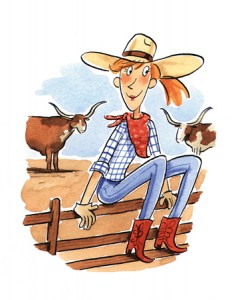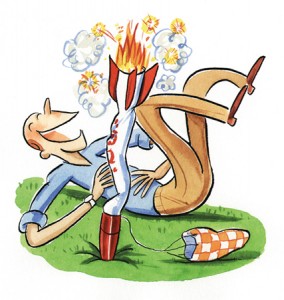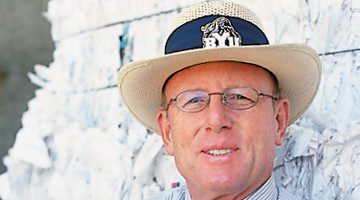Alumni recall taking learning outside the classroom.
F Is for Funny
By Hal B. Robinson (BS ’78), Olathe, Kan.
On a beautiful summer day in 1977, our Power Sources in Industry class convened in a park near campus to launch the model rockets each student had made for a class project. Excitement ran high, and some students even brought their families. Our grade for the project depended on the second and third successful recoveries of our rockets.
With a “spit” and “poof,” each rocket soared into the air for its first launch. But when I pressed the launch trigger for my rocket, it rose just three feet, leveled off, then chased after a young mother with a stroller. This scene had us all—except the mother—laughing.
Realizing my rocket was too heavy, I made some hasty field modifications to lighten it. I was sure I knew what I was doing. Everyone else stood way back.
When I pressed the launch trigger again, the rocket flew up some 16 feet, then nosed over and slammed into the ground, imbedding the nose cone into the turf less than two feet from the launch pad. I watched in horror as my rocket sputtered through the final phase of the engine burn, firing reverse thrust to pop the parachute. The nose cone was driven another four inches into the ground, and the rocket was blown to bits. A mighty cheer went up from my peers. I was laughing too hard to realize there would be no successful third recovery. Looking around, I found my instructor rolling on the grass, laughing so hard he couldn’t breathe.
Never had an F on a project brought so much delight to so many people.
Scrish, Scrish, Sploop
By David B. (BS ’02) and Malinda Wallentine Gonzalez (BS ’00), Provo
The research station was five hours by boat up the Trombetas River (a tributary of the Amazon). We traveled at night and arrived at the reserve at about 3 a.m. In the morning, we awoke to the sounds, smells, and sights of life teeming in the lushest jungle on earth. The river cut a wide swath through the succulent green canopy, only broken by fish leaping for food and the eerie pink river dolphins. The two of us, strangers prior to the trip, were invited to help in a genetic study of 170-pound freshwater turtles, accompanied by BYU biology professors Jack W. Sites, Mark C. Belk (BS ’85), and C. Riley Nelson (PhD ’86), along with two Brazilian professors and nine Brazilian students.
Around midnight, the team traveled by boat to a turtle-nesting beach, where we lay on the cool sand to wait. The sky was filled with stars, the air with the wondrous noise of howler-monkey screams and the raucous cawing of gulls warding off caiman from their nests. Finally, we heard our cue to pounce: “scrish, scrish,” then a quiet “sploop” and more “scrishing,” then “thud, thud, thud.” We leapt to our feet and stumbled in the dark toward the noise; it was a freshwater turtle that had just finished nesting and was returning to the water. Four of us ambushed the unÂsuspecting mother and wrestled her to her back to wait until morning. Without harming the turtles, we repeated this routine throughout the night. At first light we measured, weighed, tagged, and took a DNA sample from each one before returning them to the river. Bleary-eyed, we returned to our camp for a brunch of beans, farina, piranha (truly delicious), and star-fruit juice.
After spending every waking moment together for two weeks, the two of us had become good friends. We started dating upon our return and married in the summer of 2001, only to continue our adventure together in the zoology graduate program.
 Steered Toward Agriculture
Steered Toward Agriculture
By Karen Dillman Farnsworth (BS ’99), Downing, Mo.
I was an animal-science major with an emphasis in veterinary technology. I had always loved animals and felt right on track taking classes in animal health and visiting veterinary clinics.
Then, one Friday, I went on a field trip with Professor Leon E. Orme and a group of ag business students (a.k.a. cowboys and cowgirls). We spent the afternoon handling steers on a cattle feedlot in Spanish Fork.
The animals had to be coerced into an alleyway that led to a chute, where we applied ear tags, fed them dewormer, and administered a variety of vaccinations by injection. The steers bawled loudly, threw bovine snot incredible distances, and rattled around in the alleyway and chute. The growing depths of liquid steer manure provided the animals with another weapon, with which they splattered us as they stomped around and flung their tails.
We arrived back on campus covered in mud, snot, and plenty of pungent steer manure. I had to walk across campus to my car in that condition.
After an experience like that, there was only one thing to do—I changed my emphasis to ag business so I could spend more time pursuing such quality activities. The thought of a quiet, sterile vet lab no longer appealed to me.
I’m now married to a cowboy, and we own a ranch in Missouri. I’ll always be grateful to BYU and Professor Orme for broadening a city girl’s horizons.
Living the Literature
By Julie M. Pinkham (BA ’95), Queen Creek, Ariz.
After reading Edward Abbey’s Desert Solitaire—about the author’s stint as a ranger in Arches National Park—we traveled with Professors Thomas E. Lyon and J. Lynn England to Arches for our own desert experience. Two days of camping and hiking showed us the wonders and restrictions of the desert in a way the book couldn’t match. We witnessed people triumphing over nature, overcoming fear of heights or darkness or tight places, completing the arduous hikes. We gazed on the striking contrast of green sage and red sandstone, in places glazed black. We felt the solitude of the desert—how easily the wide stillness can swallow you whole.
I’ve never forgotten my gratitude for a neon sunrise seen from my lone sleeping bag atop a rock; the triumph at discovering strength as I scaled towering rocks; or the sense of power when, my face flickering in the firelight, I made people gasp at my rendition of Poe’s “The Tell-Tale Heart.” And as I stood, having crawled my way up the stones, I could feel God’s presence in the still, vast sweep of red-rock formation and mesa.
When we returned, we wrote about our experiences—as Abbey did. I kept the poem I turned in:
All together we toil,
Straining up the mountain’s back.
Hands grasp hands,
Hearts grasp hearts,
And now we stand in triumph
As One,
Panting above all fear.
Kings and Queens,
Mighty we soar
Atop the humbled sandstone.
Combat Zone
By Jennifer Kunz Hoisington (BA ’95), Cedar Mountain, N.C.
Stage combat was the only class I was willing to take at 7 a.m. The weapons we used required abundant space, so we’d take our learning outside. Dueling with a 6-foot quarter staff on the quad garnered concerned looks from passersby and became a wonderful memory, second only to my final class project: a scene from The Taming of the Shrew, performed on a patio outside the HFAC.
The scene began with my very large scene partner dragging me by the hair, screaming, across the pavement. The ensuing verbal sparring between Kate and Petrucchio quickly led to physical sparring with broadswords. These were large, heavy weapons clanking and scraping loudly amidst a barrage of Shakespearean insults, the sounds echoing in the morning air. I think we may have frightened some bleary-eyed students on their way to 8 a.m. finals.
These experiences taught me how refreshing and cathartic it is to be up and moving in the early-morning air.
I was much calmer during finals that semester, having released all my angst in a tit-for-tat, no-holds-barred argument that involved a very large sword.










